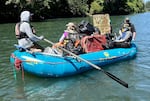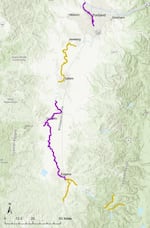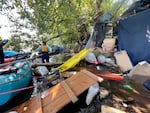Trash dumped into stretches of the Willamette River between Salem and the Columbia River has gotten so bad that local agencies may need to come up with ways to address it, according to a state report published Thursday.
The report uses data submitted by the nonprofit Willamette Riverkeeper, whose staff say the mounting trash pollution appears to be tied to increases in homelessness.
“We don’t blame those that are houseless for this trash crisis,” Willamette Riverkeeper staff attorney Lindsey Hutchison said. “Local government, state governments — they need to be providing resources.”
Hutchison said those resources could include increasing access to housing and providing dumpsters.

In this provided photo, volunteers with Willamette Riverkeeper use a raft to carry trash found along the Willamette River in Eugene in 2022.
Photo courtesy of Willamette Riverkeeper
The nonprofit has been hosting volunteer trash cleanups along various portions of the river since 2018. Staff compiled data showing how much trash volunteers collected over the years, then submitted it to the Oregon Department of Environmental Quality to use in the agency’s biennial report summarizing surface water pollution across the state.
Willamette Riverkeeper collected between 124 and 432 yards of trash (enough to fill about 50-173 level truck beds) each year, with variances based on the number and extent of cleaning events.
Oregon DEQ determined that data was enough to list sections of the Willamette River as “impaired” by pollution. That means local agencies within those river stretches could face cleanup regulations in the future. DEQ is proposing the stretches between south Eugene and north Corvallis, as well as between Lake Oswego and the Willamette’s mouth, at the Columbia River, be listed as impaired due to aquatic trash.

The Oregon Department of Environmental Quality is proposing sections of the Willamette River (highlighted in purple) be listed as impaired by trash, which could trigger regulations that require local jurisdictions to reign in that type of pollution. More data is needed for sections highlighted in yellow.
Map courtesy of Oregon DEQ
DEQ is required to submit water pollution data to the U.S. Environmental Protection Agency every two years to comply with the Clean Water Act. Using that data, DEQ can propose the EPA list certain water bodies — like streams, rivers, lakes and oceans — as impaired by a type of pollution. If the EPA confirms that a water body is impaired, then DEQ works with local jurisdictions to come up with a “total maximum daily load” plan, called a TMDL.
The TMDL is an extensive document that can take months or years to develop, and it usually includes pollution limits that local jurisdictions must meet within a time frame, as well as who should be responsible for meeting those parameters.
Oregon’s water pollution report has typically focused on temperature pollution, like when a wastewater treatment plant dumps water that is too warm for fish to survive into a stream. DEQ officials say that type of pollution is easier to measure through temperature probes, and it’s easier to identify its exact sources (like a wastewater treatment plant). Some of the data DEQ relies on is submitted by other agencies and nonprofit organizations.
Trash is a little different. There isn’t a single-point source of trash in rivers, lakes or the ocean that officials can point to and mitigate, especially when it could be tied to widespread social issues like poverty and homelessness. For that reason, just a few states have TMDLs regulating aquatic trash.
“For aquatic trash, we’re not 100% sure what that’s going to look like,” DEQ water quality assessment lead Lesley Merrick said. “So that’ll be part of the process, but the first step is the identification of impaired waters.”

In this September 2021 photo provided by Willamette Riverkeeper, volunteers help remove trash from the Upper Willamette River outside Eugene.
Photo courtesy of Willamette Riverkeeper
In addition to aquatic trash, DEQ added two additional types of water pollution to its report this year: ocean acidification and hypoxia, and PFOS, which is a subset of “forever chemicals” widely known as PFAS.
“All three of these kind of particular issues are very different and much harder to solve,” compared to water temperature pollution, DEQ spokesperson Lauren Wirtis said. “It’s not [from] a single entity or person or facility.”
In addition to the Willamette River, DEQ proposes the Columbia Slough — the 31-mile stretch of waterways between Fairview Lake and the Willamette River — be listed as impaired for PFOS based on the Oregon Health Authority’s fish consumption advisory.
DEQ is also proposing parts of the Oregon Coast be listed as impaired due to ocean acidification and hypoxia, which is linked to a changing climate. The ocean absorbs carbon dioxide, increasing acidity and depleting oxygen. DEQ based its findings on three years of data submissions, as well as a workgroup it formed.
The agency is proposing to list the stretch of coast from Cape Foulweather (south of Depoe Bay) to the Siltcoos River (north of Winchester Bay) as impaired for acidification and hypoxia. It’s also proposing the stretch of coast from the Columbia River to Cape Lookout (southwest of Tillamook) be listed for ocean acidification only. If approved by the EPA, Oregon would become the first state to have marine waters listed as impaired for ocean acidification.
